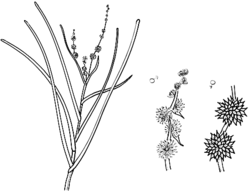
Description: Emergent rhizomatous aquatic perennials, rooting in substrate; stems usually simple.
Leaves radical at first, distichous and alternate as flowering stem elongates, emergent or floating, linear, with blade and sheathing base.
Inflorescence spicate or racemose arrangement of dense unisexual clusters, each branch or cluster (where spicate) subtended by a leaf-like bract; female clusters below male clusters on each axis. Flowers unisexual, sessile. Perianth segments 3–6, membranous, less than half as long as filaments. Male flowers with 1–8 free or partly fused stamens; anthers basifixed, 2-locular; ovary absent. Female flowers with superior 1-, 2- [or 3-]locular ovary; ovule 1 per loculus; styles as many as carpels, persisting in fruit; stigmas solitary or branched.
Individual fruit indehiscent, tough, 1-seeded.
Distribution and occurrence: World: 20 species, mostly Northern Hemisphere. Australia: 2 species (1 species native, 1 species naturalized), Qld, N.S.W., Vic.
Text by S. W. L. Jacobs (1993); edited KL Wilson (April 2013)
Taxon concept:
| | Key to the species | |
| 1 | Leaves usually less than 5 mm (rarely to 9) mm wide, yellow-green; inflorescence unbranched or with 1–3 branches; female heads all subtended by a leaf-like bract; fruits narrowly obovoid, c. twice as long as wide; tepals usually with 1–2 longitudinal veins | Sparganium subglobosum |
| Leaves 8–22 mm wide, mid-green; inflorescence 4–6-branched; female heads mostly not subtended by a leaf-like bract; fruits broadly obovoid, c. as long as wide; tepals with 2–6 longitudinal veins | Sparganium erectum |
|


